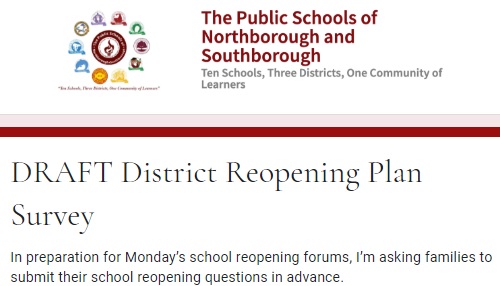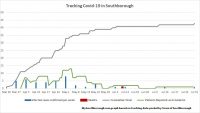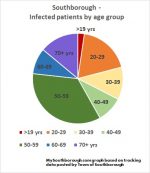Above: Parents have until 2pm tomorrow (Sunday, August 2nd) to submit questions for Community Forums on school Reopening Plans. The question form also serves as a survey that all parents are being asked to complete. (image cropped from survey)
On Friday night, the Public Schools of Northborough and Southborough emailed its “July NSBORO News” to parents. Those who opened it will have seen that the monthly newsletter included the Draft Reopening Plan. It also gave a quick turnaround for submitting questions on the plan in time for Community Forums that will be held on Monday.
A follow up email this morning from the Superintendent points out what that original message didn’t make clear. Even parents without questions are asked to open the form, since it also includes an important survey. The survey’s focus is gauging parents’ “preferred model for reopening in the fall” given the details in the Reopening Plan.
The response deadline is listed as tomorrow (Sunday, August 2nd) at 2:00 pm. The first forum will be held the following morning.
The newsletter introduced the Draft Plans, explaining:
Over the past six weeks, The Public School of Northborough and Southborough educators, school-based leaders, and the Central Office Leadership Team have been planning for the 2020-2021 school year and the reopening of our schools. The planning has been guided by seven priorities, which are listed below, with the first being the most essential: The physical, social, and emotional well-being of students, faculty, and staff. . .
The DRAFT District Reopening Plan provides a framework and guidelines for health, safety, and well-being, teaching and learning, student support services, English language development, technology, and school facilities operations.
The teaching and learning planning has centered around identifying four potential reopening models: In-person, Hybrid, Full Remote, and Stand Alone Remote Program. Due to the unpredictability of the trajectory of the virus in our community, the models allow for smooth transitions among them. If the District needs to transition from a hybrid model to a remote model or from a hybrid model to a fully in-person model, we will be able to do so efficiently and effectively. At this time, a recommendation to the school committees regarding a reopening model has not been made.
The final sentence above is an interesting one.
In previous posts this week, I wrote that the district was recommending the Hybrid Model. It is true (as I noted) that the school committees weren’t being asked to vote yet on a model to start the year off under. However, the administration did clearly advocate for the Hybrid Model both for K-8 schools and Algonquin during presentations to school committees this week.
Still, both community feedback and the state of infection numbers in the area could impact the final recommendation.
In terms of infection numbers, Southborough’s have been low this summer. One new case was reported yesterday, the first since July 6th. (Interestingly, it’s the first confirmed patient under the age of 20.) The active cases for the Town has only reached 43, and only one of those is still actively in isolation. (Click below for graphs tracking Southborough’s infection data.)
Northborough has had a higher case rate, though it slowed down this summer. As of Wednesday, when the state released it’s weekly report, Northborough reached 227 infected residents. But, less than 5 were indicated as active cases, with three of those having been confirmed in the past week. (It is worth noting that Northborough’s numbers include two nursing homes.)
Back to the district’s message. . .
- Click here for the Newsletter message
- Click here for the Draft Reopening Plans
- Click here for the survey and question form
Below are details for the forums on Reopening Plans scheduled for Monday, August 3rd. (Remember to submit the questions in advance):
- Elementary Community Forum – Northborough & Southborough (7:00 – 8:15 am) – register here
- ARHS Community Forum (12:00 – 1:15 pm) – register here
- Middle School Community Forum – Melican & Trottier (4:30 – 5:45 pm) – register here
Other dates worth noting:
- Student Support Services Forum on reopening (Week of August 9th, date TBD)
- Combined School Committee Meeting – Wednesday, August 5, 6:00 pm (The committees are expected to vote on the Reopening Plans but not which specific model to adopt. They will also address “2020-2021 Calendar – Time on Learning”. A vote on which model to begin the year under will wait until the following week.)
Updated (8/2/20 12:08 pm): In going through the Reopening Plan, there was a highlight I thought worth noting – at least for K-8 students. (It’s not as big of a change for ARHS students.) Students will each have a dedicated tech device (chromebook/ipad):
Deploying 1:1 Devices for Students
All students, K-12, will have access to a device in order to reduce the sharing of materials in school. In addition, having a 1 to 1 device program allows the District to be prepared for remote learning should it be necessary. At Algonquin Regional High School, the program will continue like last year with some students bringing their own device while others are issued a device by the school for the school year. In Grades K-8, students will be issued Chromebooks or Ipads. Families will be asked to complete a contract and will be provided a low-cost option for insurance on the device, if they choose.





Some argue ventilation is not being given the priority it should in the overall “mitigation stack,” particularly when it comes to schools. Here’s an excerpt from Zeynep Tufekci, writing in The Atlantic. Read the whole thing if you have the opportunity.
[Professor of Environmental Engineering] Marr told me that she “sheepishly” switched her elementary- and middle-school-age children to a private school because she was able to make a case with the school to take “good ventilation” seriously, in addition to wearing masks and social distancing. Not every school will have such resources, but maybe providing those resources is exactly what we should aspire to for all schools. If the signatories of the letter to the WHO are correct, then adding ventilation to our mitigation stack is exactly what we should focus on, doing everything necessary ranging from the more expensive upgrades to our air-quality infrastructure to opening the windows that are right within our reach.
We Need to Talk About Ventilation
How is it that six months into a respiratory pandemic, we are still doing so little to mitigate airborne transmission?
https://www.theatlantic.com/health/archive/2020/07/why-arent-we-talking-more-about-airborne-transmission/614737/
…In particular, the size of infectious particles really matters, because that determines how they travel—are they big enough to be quickly pulled down by gravity or are they small enough to float around?
…There is a big dispute in the scientific community, however, about both the size and the behavior of these particles, and the resolution of that question would change many recommendations about staying safe.
…Saskia Popescu, an infectious-disease epidemiologist, emphasized to me that we should not call these “super-spreaders,” referring only to the people, but “super-spreader events,” because they seem to occur in very particular settings—an important clue.
…But that’s not all. The super-spreader–event triad seems to rely on three V’s: venue, ventilation, and vocalization. Most super-spreader events occur at an indoor venue, especially a poorly ventilated one (meaning air is not being exchanged, diluted, or filtered), where lots of people are talking, chanting, or singing.
…All this has many practical consequences. As Marr, from Virginia Tech, says, if aerosols are crucial, we should focus as much on ventilation as we do on distancing, masks, and hand-washing, which every expert agrees are important. As the virologist Ryan McNamara of the University of North Carolina told me, all these protections stack on top of one another: The more tools we have to deploy against COVID-19, the better off we are.
Similarly, Jimenez pointed out that, when a masked person is speaking, the least safe location might be beside them or behind them, where the aerosols can escape from the mask, though ordinarily, under a droplet regime, we would consider the risk to only be in front of them. The importance of aerosols may even help explain why the disease is now exploding in the southern United States, where people often go into air-conditioned spaces to avoid the sweltering heat.
…There are two key mitigation strategies for countering poor ventilation and virus-laden aerosols indoors: We can dilute viral particles’ presence by exchanging air in the room with air from outside (and thus lowering the dose, which matters for the possibility and the severity of infection) or we can remove viral particles from the air with filters.
…Consider schools, perhaps the most fraught topic for millions. Classrooms are places of a lot of talking; children are not going to be perfect at social distancing; and the more people in a room, the more opportunities for aerosols to accumulate if the ventilation is poor. Most of these ventilation issues are addressable, sometimes by free or inexpensive methods, and sometimes by costly investments in infrastructure that should be a national priority.
Last week, I walked around the public elementary school in my neighborhood while thinking about what we could do if we took aerosol transmission more seriously. It’s a single-story building, all the classrooms have windows, some have doors that open directly to the outside, and many have a cement patio right outside. Teaching could move outdoors, at least some of the time, the way it did during the 1918 pandemic. Moreover, even when indoors or during rainy days, opening the doors and windows would greatly improve air circulation inside, especially if classrooms had fans at the windows that pushed air out.
Read: Why can’t we just have class outside?
When windows cannot be opened, classrooms could run portable HEPA filters, which are capable of trapping viruses this small, and which sell for as little as a few hundred dollars. Marr advises schools to measure airflow rates in each classroom, upgrade filters in the HVAC system to MERV 13 or higher (these are air filter grades), and aspire to meet or exceed ASHRAE (the professional society that provides HVAC guidance and standards) standards. Jimenez told me that many building-wide air-conditioning systems have a setting for how much air they take in from outside, and that it is usually minimized to be energy-efficient. During a pandemic, saving lives is more important than saving energy, so schools could, when the setting exists, crank it up to dilute the air (Jimenez persuaded his university to do that).
Jimenez also wondered why the National Guard hadn’t been deployed to set up tent schools (not sealed, but letting air in like an outdoor wedding canopy) around the country, and why the U.S. hadn’t set up the mass production of HEPA filters for every classroom and essential indoor space. Instead, one air-quality expert reported, teachers who wanted to buy portable HEPA filters were being told that they weren’t allowed to, because the CDC wasn’t recommending them. It is still difficult to get Clorox wipes in my supermarket, but I went online to check, and there is no shortage of portable HEPA filters. There is no run on them.
…Japan was expected to fail by many, as it implemented an unconventional response, bucking WHO guidelines, eschewing widespread testing, and forcing few formal lockdowns. However, Japan masked up early, focused on super-spreader events (a strategy it calls “cluster busting”), and, crucially, trained its public to focus on avoiding the three C’s—closed spaces, crowded places, and close conversations. In other words, exactly the places where airborne transmission and aerosols could pose a risk… Six months later, despite having some of the earliest outbreaks, ultradense cities, and one of the oldest populations in the world, Japan has had about 1,000 COVID-19 deaths total—which is how many the United States often has in a single day. Hong Kong, a similarly dense and subway-dependent city, has had only 24 deaths.
To be clear, the science concerning aerosols isn’t settled, which is acknowledged by the signatories of the letter to the WHO urging recognition and mitigation of possible aerosol risks …This is especially crucial because mitigations stack: The more we have available, the more effective they become.
During the Regional School Committee Meeting, attention to ventilation was discussed. Apparently a parent from the school system has HVAC quality expertise and partnered with administration staff to examine systems. Page 20 of the Reopening plan is dedicated to the topic: https://www.nsboro.k12.ma.us/cms/lib/MA02216193/Centricity/Domain/56/Draft%20District%20Reopening%20Plans%20-Public%20Schools%20of%20Northborough%20and%20Southborough.pdf
Not included there, but mentioned in the meeting, staff will be allowed to use fans, but they must be fixed, not oscillating.
Parents please vote for 100% remote for the fall semester. Kids only learn 60% under the Hybrid model. The two days a week at home are for doing homework, not synchronous learning via Zoom. For high schoolers, losing 40% learning is significant. We are risking our lives to get only 60%. Let’s vote for 100% remote and re-evaluate for the Spring semester.
In addition, there is no social at school under the Hybrid model. 6 ft apart, no playground, one-way path in the buildings, and lunch alone. Kids cannot follow the rules, and wearing masks all day is BAD for their lungs.
For children over two years, there is no evidence that wearing a mask is bad for a child’s lungs or bad for the child. It’s important to accept and respect science while discussing and debating what to do in response to it. The recent years of gaslighting have caused many to not understand the difference.
The recommended Hybrid model delivers sub-standard education with 2 days a week at home just doing homework. We need 100% education. Why not start the Fall semester with 100% remote? We can always evaluate again for the Spring semester with real data from other districts and nationwide.
Yes the case numbers are low for now because there are no schools. Things will change. And all pandemics start with a low number. Please do not ignore the fact that this is a highly infectious disease. Be prudent. We have worked so hard to keep the numbers low.
There are no normal social interactions at school. All adults are nervous so everyone is under strict watch. Playgrounds are closed. In addition, wearing masks ALL DAY is very uncomfortable and BAD for children.
Apparently you did not read the content at the link Frank Crowell posted in the other, related story:
https://www.nejm.org/doi/full/10.1056/NEJMms2024920
The New England Journal of Medicine article leads one to the conclusion that the kids should be IN SCHOOL with NO REMOTE time. Looking more closely, it would seem it is the non-juvenile school population with the greatest concerns. These can be addressed with masks, hand washing, etc.
It’s easier to keep the kids at home – for the school staff…
It’s only their education we’re talking about…
Yup. Don’t forget the American Academy of Pediatrics which states something very similar with the additional “Schools provide more than just academics to children and adolescents. In addition to reading, writing and math, children learn social and emotional skills, get exercise and access to mental health support and other things that cannot be provided with online learning. For many families, school is where kids get healthy meals, access to the internet, and other vital services.”
Not every family has the resources to be part time hybrid, if not full time at home. If people don’t want their kids in school that is fine, they should have that option, but it shouldn’t influence those that DEPEND on school as a basic necessity. Other than medical, I can’t think of many more essential services for our society. If some teachers don’t want to work, that is fine, but can I not pay my taxes which funds their salaries? I know there are a lot of teachers that want to be their for the kids in person, I have talked to them, and I feel bad that they are being prevented to do their jobs that they would willingly do if allowed.
This is a very slippery slope. What will it take for us to ever have full time school again? That simple question was surprisingly never addressed in any of the school Zoom videos. No one can guarantee there will be a vaccine, and if there is, not everyone will take it. Cases may never fully be irradiated….does that mean we never go to school full time again?
To suggest 100% at-home is a good option is laughable for many families with 2 working parents and especially with younger kids. Our children’s education is taking a back seat – we all know online learning cannot replicate the in-school experience…especially the younger ones.
Our school system states we meet the minimum requirements for full in-school learning as we can meet the 3 foot threshold. However we have chosen to be more stringent, with no explanation other than “its better”. Also, children with certain disabilities can go mask free in class if approved, but they supposedly “aren’t at risk” because desks will be 6 feet apart. So, with that said, not sure why anyone has to wear a mask in class if they are all 6 feet apart. Sorry, but you can’t have it both ways. Either 6 feet is enough or it isn’t. Or did I miss the medical evidence that suggests children with learning disabilities don’t transmit COVID when they sneeze or cough?
I don’t think any teacher thinks that trying to educate kids remotely is easier.
You really think all this bouncing around and teaching remotely is easier? If you’re so on board with full in person school, let them do hybrid and realize full in school is possible. And take a deep breath, keep the blood pressure down.